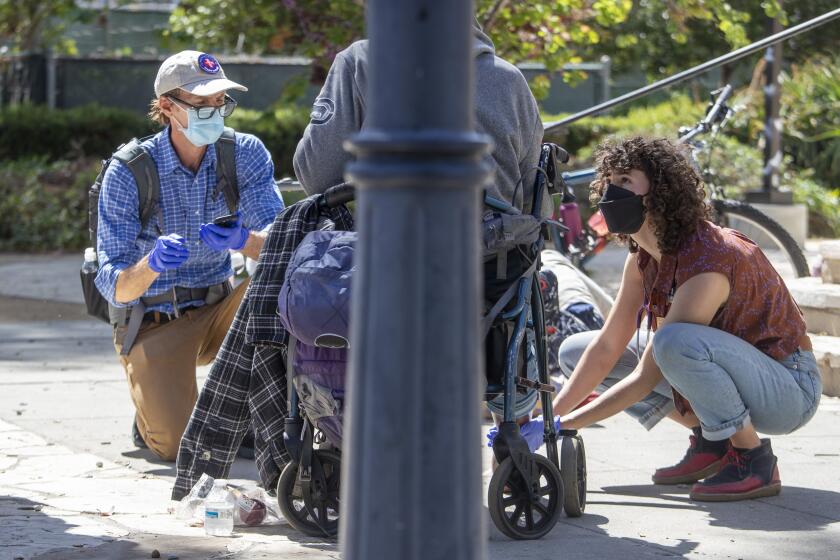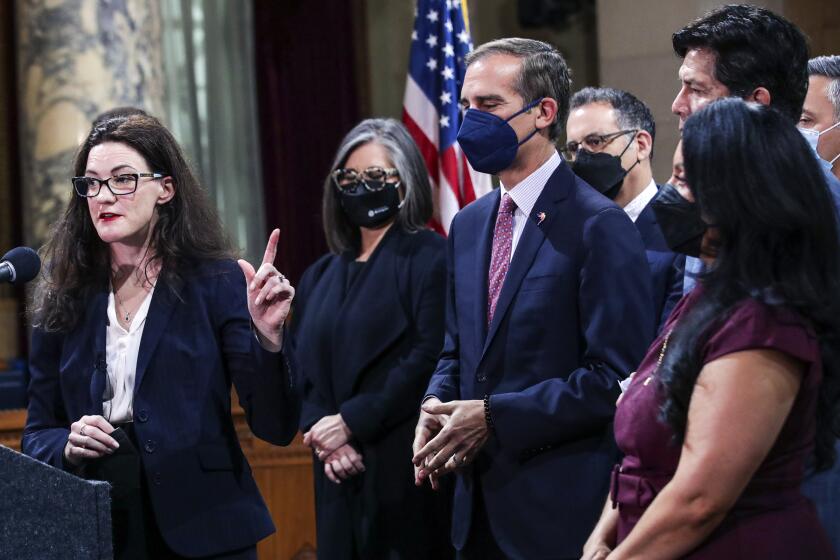A new skid row facility where homeless women can try ‘to get whole and heal’
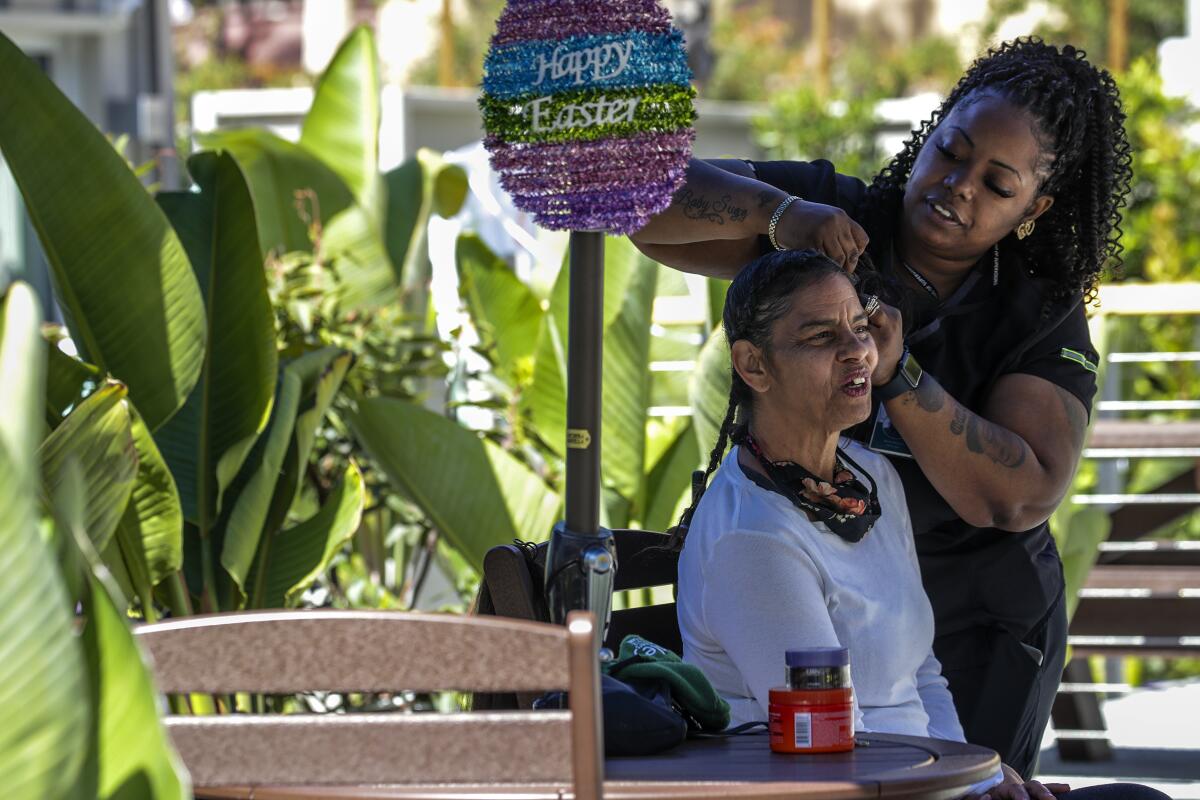
- Share via
Before she ended up in the hospital, “I felt like I was invincible,” said Jillian, 58, who suffered liver failure. “But I was not.”
Alcohol had derailed her life. She had trouble holding down a job and had strained ties with her family and friends. When she was discharged from the hospital to a program in skid row, it was not the life that any little girl dreams of, said Jillian, who asked to be identified only by her first name to protect the privacy of her family.
For the record:
6:34 a.m. April 22, 2022An earlier version of this article erroneously referred to Abbye Williams as Abbye Walker.
But she eventually “ended up in the right spot with the right people” — a clean and tranquil site dotted with palm trees that can feel a world away from skid row.
It is called the Oasis, a 40-bed site run by Wesley Health Centers and created through a joint effort of the city and county of Los Angeles.
“This is a good place,” Jillian said, “for women to get whole and heal.”
This skid row facility provides “recuperative care,” which includes medical monitoring, counseling and case management, for homeless people who are medically vulnerable. Such sites have traditionally served unhoused people who have just been released from hospitals, offering the kind of basic care that other Angelenos might get from family or friends at home as they recover.
Progress is finally being made in deploying vans with street medicine teams to help L.A.’s massive homeless population.
Without such care, “if they have a wound that’s healing, it can’t be cleaned. They don’t have a refrigerator to put their medicine in,” said Libby Boyce, senior director of programs for the Housing for Health division at the L.A. County Department of Health Services. “Just like anybody who leaves a hospital — they get to go home and somebody watches to make sure they’re OK.”
The programs are meant to halt the revolving door between the emergency room and the streets for homeless people.
One analysis that focused on urban hospitals in Connecticut and Florida calculated that such programs, also known as “medical respite,” shorten the typical length of hospital stays for unhoused patients by two days and reduce future trips to the hospital, saving $1.81 for every $1 invested. In L.A. County, researchers also saw an increase in patients using primary care — the bread-and-butter medical services that can prevent future crises.
The goal is to stabilize people so that they can recover mentally and physically and hopefully get into housing, proponents say.
“We often get asked the question, ‘Is this solving a healthcare problem, or a housing problem?’” said Julia Dobbins, director of medical respite for the National Health Care for the Homeless Council. “And the answer is, ‘Yes. It’s both.’”
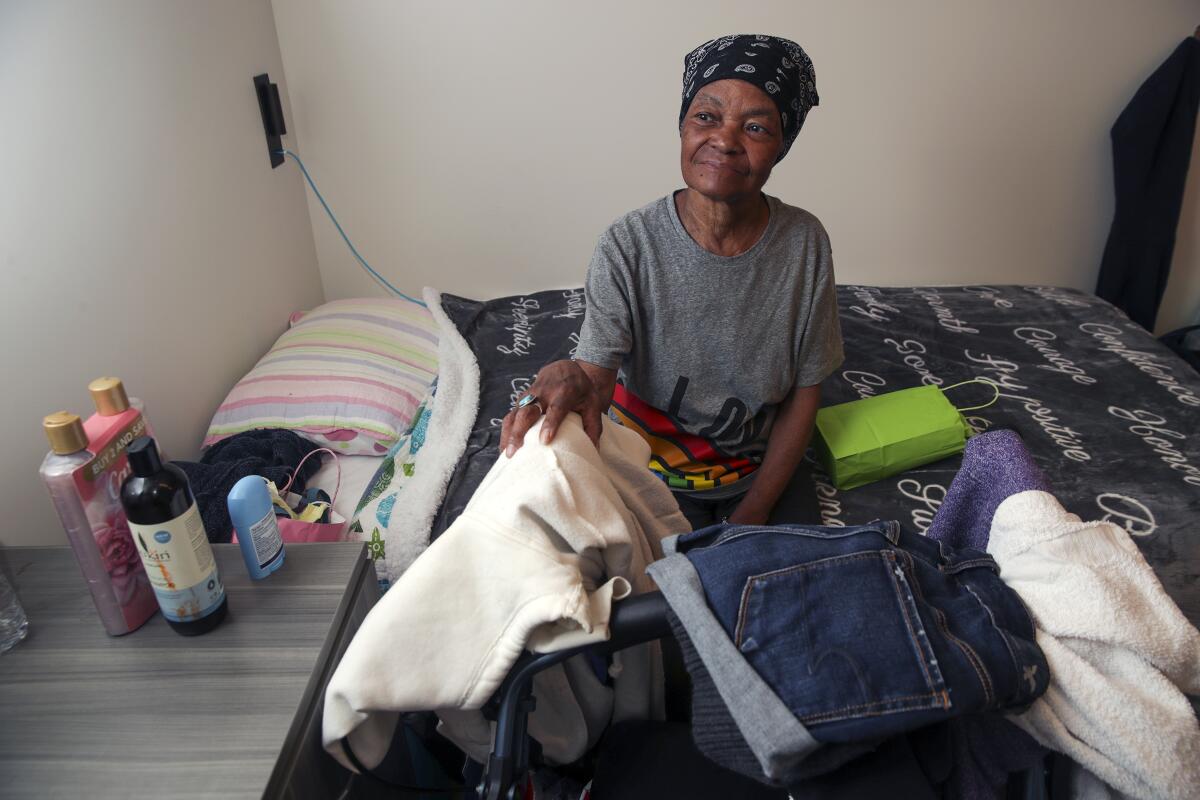
Besides people exiting hospitals, recuperative care has also been used by county Health Services as an option for homeless people whose medical or psychiatric conditions make it hard for them to live in a typical shelter.
They need to be independent enough to handle daily activities, but may be grappling with schizophrenia, living with amputated limbs, using colostomy bags, or managing chronic conditions like diabetes, staffers said.
The Oasis is the first such facility under the Housing for Health program that is specifically for unhoused women, many with bracing histories of trauma and abuse.
In an assessment three years ago, the Downtown Women’s Center found that 44% of homeless women surveyed in Los Angeles had been a victim of a crime in the previous year, 36% had experienced domestic violence and 27% had been sexually assaulted over that time. Nearly 60% rated their mental health as fair or poor. More than 40% said they had an ambulatory disability.
“This was the best place, closest to home, for being able to be myself and feel kind of human, and get back to where I was,” said Cynthia Taylor-Davis, 72, who said she had been at the facility for three months. “I want to be able to go back to work. Walk normally. And most of all, get over my depression from the loss of my daughter.”
Taylor-Davis said she has struggled since losing her daughter to esophageal cancer. She thinks the disease should have gotten her, she said, before it got her daughter. She is also trying to regain her mobility after hip replacements. She remembers, wistfully, that it’s been years since she was able to ride a bike.
“It gives me confidence to take a step without falling down. I’ve had a romance with the cement a few times,” Taylor-Davis said. “I can laugh about it now ... but it wasn’t a laughing matter.”
Inside the Oasis, the walls are painted in serene shades of sage and aqua and hung with glossy photographs of the woods. The dorms are structured with segments like cubicles that have sliding doors to afford a bit of privacy.
Edenia Jones, associate director of recuperative care and enriched services programs with Wesley Health Centers, is still fixing up the community room, where she envisions having computers and a workout area. The women recently celebrated a “spring fling” in the courtyard with a DJ, catered food and ice cream, where some got up and sang karaoke.
“I want it to feel like home for them,” Jones said.
Jillian, who used to work as a veterinary nurse, remembers first arriving at another recuperative care program run by Wesley Health Centers and trying to hand over her food stamps and general relief payments to the intake coordinator, who refused them. “Don’t I have to give this to you so I can stay here?” she remembers asking him. “He said, ‘No, no, we provide everything for you.’”
After the lights come on each morning and she gets up, she often heads out to medical appointments off-site. “You find out, after not taking good care of yourself for a couple years, there’s a lot of things wrong with you,” she said. “Especially with my age group.”
She sees a hepatologist. A heart specialist. A neurologist. An ophthalmologist. She started going to relapse prevention for alcohol use. Her hepatitis C has disappeared, she said, and she hasn’t been back to the hospital for liver failure. In the Oasis courtyard, a staffer tended to her hair under the shade of an umbrella.
She wants to start working with animals again, maybe volunteer. And her ultimate goal is to move closer to her grandson.
“I’ve missed so much already,” Jillian said. “He’s going to be 3.”
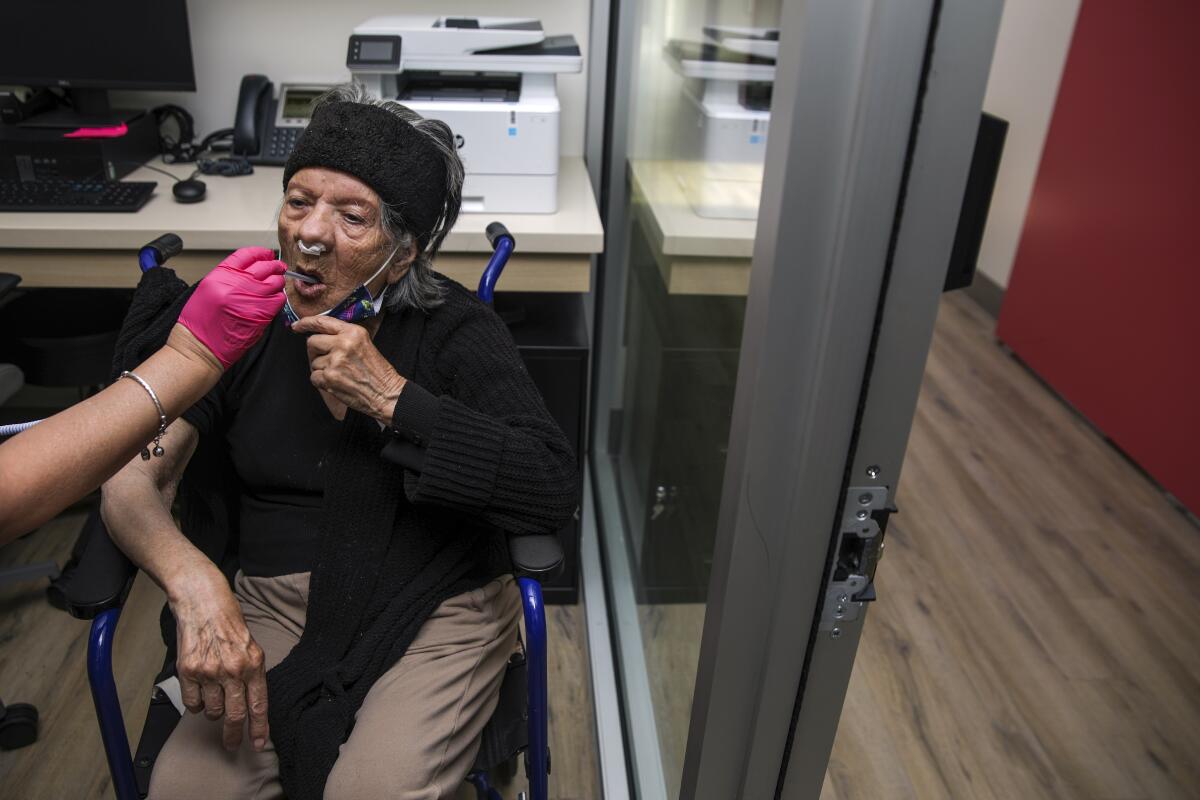
In Los Angeles County, “demand for recuperative care beds currently far outpaces supply due to record levels of homelessness, profound shortages in all forms of housing” and the requirements of a state bill meant to stop patient dumping, a report prepared for the UniHealth Foundation two years ago found.
How to help L.A.’s sickest homeless people has aggravated a growing rift between the city and county, which for several years had worked together to address homelessness.
Although the programs cost far less than keeping a homeless patient in a hospital, they had not generally been covered by Medi-Cal in the past. That meant that many hospitals “were basically paying for it out of their own funds,” said Paul Young, senior vice president of public policy and reimbursement for the Hospital Assn. of Southern California.
The UniHealth report found that as a result, private hospitals rarely paid for stays beyond a month. Health officials hope that changes in Medi-Cal may help: As of January, recuperative care can be covered for a few months under CalAIM, a new plan to remake the Medi-Cal system.
Even before that change, L.A. County had been funding longer stays in recuperative care through its Housing for Health program, which got some funding through a pilot program for Medi-Cal beneficiaries called Whole Person Care. Housing for Health now has more than 700 beds for recuperative care across the county, with more in the works.
Day-to-day operations at the Oasis are funded by the city through the Los Angeles Homeless Services Authority, and the county through Measure H, a sales tax that pays for homeless services.
If someone no longer needs the level of care that the program provides, the DHS tries to find them another place, either in interim or permanent housing. But “even people who have a housing voucher are having a challenge finding apartments,” Boyce said. That means people are staying longer in interim housing — upwards of six months and sometimes as long as a year, she said.
Dobbins, with the National Health Care for the Homeless Council, said the same problem is facing programs across the country. When someone is ready to leave, “the ideal is not to put somebody back into a homeless situation that brought them to respite in the first place. We don’t want people cycling in and out of respite programs.”
“And that’s really hard right now because of our lack of housing options,” Dobbins said.
Among the Oasis residents is Maria Todd, 86, who had once been staying in a skid row shelter. Oasis staffers said the elderly woman had been victimized there; Todd said her purse was stolen but blamed herself for getting distracted while watching television. She had taken out thousands of dollars from the bank to send to her epileptic son in Mexico, she said.
“We have vowed to keep her until we can actually provide her an appropriate place to go,” said Abbye Williams, program director of recuperative care and enriched services with Wesley Health Centers. “Because she just doesn’t need to be victimized anymore.”
Todd, who switches between speaking English and Spanish, has been in recuperative care for roughly two years, initially at another site run by Wesley Health. She griped that “they don’t let me go outside by myself,” but said that “they take me to the doctor, whatever I need.” What she really wants, Todd said, is a home — a new one in Mexico.
“A good house, made of stone, not wood,” Todd said in Spanish. “So that I can die there.”
“It’s my dream,” Todd said. “Dreaming doesn’t cost anything.”
More to Read
Sign up for Essential California
The most important California stories and recommendations in your inbox every morning.
You may occasionally receive promotional content from the Los Angeles Times.
